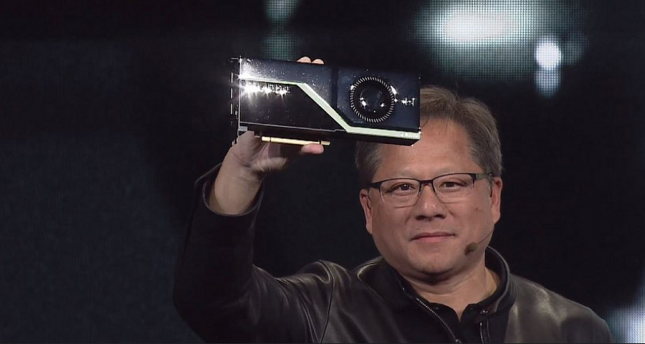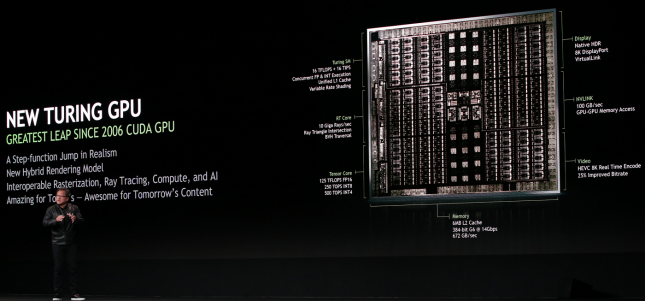NVIDIA Turing GPU Architecture Arrives on Quadro RTX Series Cards – Will Solve 8K Bottleneck
NVIDIA CEO Jensen Huang took the main stage at SIGGRAPH 2018 last night and finally unveiled the Turing GPU architecture, which is the successor to Pascal. NVIDIA’s eighth-generation GPU architecture is being touted being “the greatest leap since the invention of the CUDA GPU in 2006,” and that it “fundamentally changes how computer graphics will be done.” These also happen to be the first GPUs on the market to be running Samsung’s 16Gb GDDR6 memory.
Jensen then went on to announce the first three cards that will be using Turing GPUs – NVIDIA Quadro RTX 8000, Quadro RTX 6000 and Quadro RTX 5000. These three Quadro RTX GPUs will be available in Q4 2018 and are aimed at the those doing the most demanding visual computing workloads. The Quadro RTX 8000 model is the flagship card with 4608 CUDA cores, 576 Tensor cores and 48GB of Samsung GDDR6 memory on it!
All three models still use the PCI Express 3.0 x16 interface, but have NVLink connectors on them to pair cards together with another for even more performance. When two RTX 8000 cards are paired together they have a memory pool of 96GB, which is great for rendering farms. The Quadro RTX cards aimed at film and those involved in video content creation; automotive and architectural design; and scientific visualization. NVIDIA claims that the new Turing GPU makes it possible for video editors and color graders to work with 8K footage in full resolution in real time reaching greater than 24 frames per second using just a single-processor PC with one Quadro RTX GPU. That is big news for those working with 8K video right now on applications like Adobe Premiere Pro, Blackmagics DaVinci Resolve and Autodesk Flame. New capabilities will be possible with the NVIDIA RTX Tensor Cores and RT Cores available with Turing.
| GPU | GDDR6 Memory | Memory with NVLink | Ray Tracing | CUDA Cores | Tensor Cores | Price |
| Quadro RTX 8000 | 48GB | 96GB | 10 GigaRays/sec | 4,608 | 576 | $10,000 |
| Quadro RTX 6000 | 24GB | 48GB | 10 GigaRays/sec | 4,608 | 576 | $6,300 |
| Quadro RTX 5000 | 16GB | 32GB | 6 GigaRays/sec | 3,072 | 384 | $2,300 |
NVIDIA Turing GPU Groundbreaking Technologies:
- New RT Cores to enable real-time ray tracing of objects and environments with physically accurate shadows, reflections, refractions and global illumination.
- Turing Tensor Cores to accelerate deep neural network training and inference, which are critical to powering AI-enhanced rendering, products and services.
- New Turing Streaming Multiprocessor architecture, featuring up to 4,608 CUDA cores, delivers up to 16 trillion floating point operations in parallel with 16 trillion integer operations per second to accelerate complex simulation of real-world physics.
- Advanced programmable shading technologies to improve the performance of complex visual effects and graphics-intensive experiences.
- First implementation of ultra-fast Samsung 16Gb GDDR6 memory to support more complex designs, massive architectural datasets, 8K movie content and more.
- NVIDIA NVLink to combine two GPUs with a high-speed link to scale memory capacity up to 96GB and drive higher performance with up to 100GB/s of data transfer.
- Hardware support for USB Type-C and VirtualLink, a new open industry standard being developed to meet the power, display and bandwidth demands of next-generation VR headsets through a single USB-C connector.
- New and enhanced technologies to improve performance of VR applications, including Variable Rate Shading, Multi-View Rendering and VRWorks Audio.
To show the power that the new Quadro RTX graphics cards, Jensen Huang fired up Epic Games Star Wars-themed Reflections ray-tracing demo. He then showed the audience that in this real-time ray tracing demo the Turing RT cores have improved real-time ray tracing operations by 25x over the previous Pascal generation GPUs. He also noted that the CUDA cores, RT cores and Tensor (AI) cores in the Turing GPU can be used as denoise accelerators for 3D rendering and not just tied to deep learning projects.
These are not models meant for gaming as NVIDIA has yet to announce what they have planned for the gaming community. The do have a new teaser up on YouTube and it looks like something big will be happening on August 20th, 2018 in Cologne Germany for gamers. The Turing architecture looks like it will be a beast and we can’t want to see all the products that NVIDIA will announce in the months ahead.


